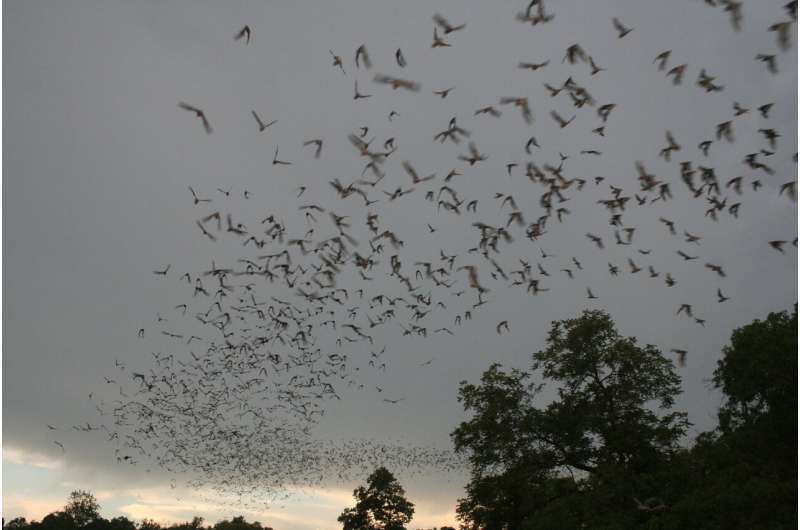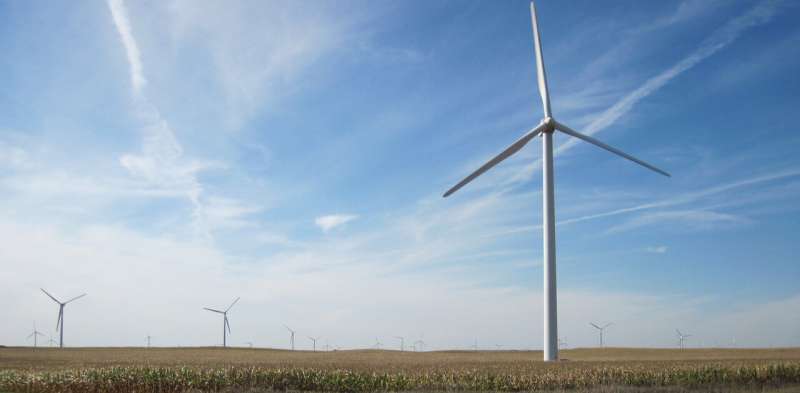Bats soaring across the sky. Credit: USFWS/Ann Froschauer.
High-resolution radar and night vision cameras may help scientists protect bats from untimely deaths at wind farms, according to new research.
Researchers are using these technologies to provide more specific details about the number of bats killed by wind turbines in Iowa. These details will improve scientists' understanding of bat activity and potentially save their lives, said Jian Teng, a graduate researcher at the University of Iowa who presented the work this week at the 2019 American Geophysical Union Fall Meeting in San Francisco.
This work has broad impacts, according to Teng. "The more bats you kill, the more insects you have on farms; then, farmers will put more pesticides; and then, people will eat more pesticides," he said. By having a reliable system for counting bats, researchers will be able to effectively explore whether certain conditions are attracting bats to wind turbines.
Wind farms—collections of wind turbines that convert wind energy to electricity—are promising sources of renewable energy. But the construction of massive wind turbines comes with environmental costs: bats soaring across the night often sky drop dead after colliding into rotating wind turbine blades.
In North America, wind turbines are estimated to kill tens to hundreds of thousands of bats each year, according to the USGS. An understanding about the impact of wind farms on bats is particularly important in Iowa.
"There are a lot of species of bats in the Great Lakes region and also in Iowa," Teng said. "When bats do their fall migration, they fly from north to south and pass Iowa. Iowa is full of wind farms," he said. The region is also home to the endangered Indiana bat.
Wind turbines in Iowa. Credit: Bill Whittaker
In the newly presented work, the researchers used a kind of high-resolution Doppler radar—similar to what meteorologists use for weather forecasting—to detect bats flying near wind turbines in Iowa at night. The researchers collected data for 50 nights during the bat fall migration period from August 2018 to October 2018.
"I was like a bat person: I stayed up all night," Teng said.
The radar signals, however, didn't necessarily correspond to bats—the instruments can also pick up signals from passing birds. To validate their measurements, the researchers compared their radar data with counts of bat corpses found near the wind turbines. They confirmed that days where they saw increased radar signals corresponded with days where more bat corpses were collected. The findings suggest the radar signal could serve as a proxy for the number of bats.
There are some caveats to these counts, Teng said. The surveyed area was large, so bat corpses were only identified around a subset of the wind turbines. Further, corpses could also be eaten by local wildlife prior to getting cataloged.
To further validate their findings, the researchers turned to a second form of imaging: infrared, or "night vision." They positioned cameras on the ground, pointing up toward the wind turbine blades, and on the wind turbine itself, pointing down toward the ground, to capture bat activity.
Rather than watching 9,000 hours of video footage, the researchers first identified footage with moving objects and then used artificial neural networks—a type of machine learning—to automatically identify flying bats. Preliminary studies indicate the automated approach works well. In the future, Teng hopes to combine radar and infrared camera results to get a high-confidence count of bats in wind farms.
Provided by American Geophysical Union
This story is republished courtesy of AGU Blogs (http://blogs.agu.org), a community of Earth and space science blogs, hosted by the American Geophysical Union. Read the original story here.























